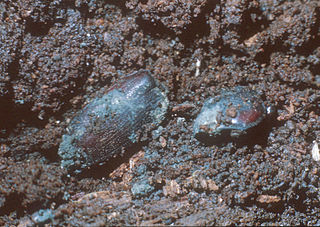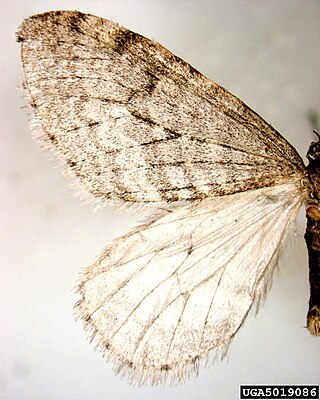
Polydnaviriformidae ( PDV) is a family of insect viriforms; members are known as polydnaviruses. There are two genera in the family: Bracoform and Ichnoviriform. Polydnaviruses form a symbiotic relationship with parasitoid wasps. Ichnoviriforms (IV) occur in Ichneumonid wasps and Bracoviriforms (BV) in Braconid wasps. The larvae of wasps in both of those groups are themselves parasitic on Lepidoptera, and the polydnaviruses are important in circumventing the immune response of their parasitized hosts. Little or no sequence homology exists between BV and IV, suggesting that the two genera have been evolving independently for a long time.

Baculoviridae is a family of viruses. Arthropods, among the most studied being Lepidoptera, Hymenoptera and Diptera, serve as natural hosts. Currently, 85 species are placed in this family, assigned to four genera.

Dynastinae or rhinoceros beetles are a subfamily of the scarab beetle family (Scarabaeidae). Other common names – some for particular groups of rhinoceros beetles – include Hercules beetles, unicorn beetles or horn beetles. Over 1,500 species and 225 genera of rhinoceros beetles are known.
Cydia pomonella granulovirus (CpGV) is a granulovirus belonging to the family Baculoviridae. It has a double-stranded DNA genome that is approximately 123,500 base pairs in length with 143 ORFs. The virus forms small bodies called granules containing a single virion. CpGV is a virus of invertebrates – specifically Cydia pomonella, commonly known as the Codling moth. CpGV is highly pathogenic, it is known as a fast GV – that is, one that will kill its host in the same instar as infection; thus, it is frequently used as a biological pesticide.
Animal viruses are viruses that infect animals. Viruses infect all cellular life and although viruses infect every animal, plant, fungus and protist species, each has its own specific range of viruses that often infect only that species.

Mermithidae is a family of nematode worms that are endoparasites in arthropods. As early as 1877, Mermithidae was listed as one of nine subdivisions of the Nematoidea. Mermithidae are confused with the horsehair worms of the phylum Nematomorpha that have a similar life history and appearance.

Nudiviruses are animal viruses that constitute the family Nudiviridae. Insects and marine crustaceans serve as natural hosts. There are 11 species in this family, assigned to 4 genera. Diseases associated with this family include: death in larvae, chronic disease in adults.

Metarhizium majus is the name given to a group of fungal isolates that are known to be virulent against Scarabaeidae, a family of beetles. Previously, this species has had variety status in Metarhizium anisopliae and its name is derived from characteristically very large spores for the genus Metarhizium. There has been considerable interest in developing isolates of this species into mycoinsecticides: especially against the coconut and oil palm beetle pest Oryctes in SE Asia, the Pacific region and Africa.

Operophtera bruceata, the Bruce spanworm, hunter's moth, or native winter moth is a moth of the family Geometridae. The species was first described by George Duryea Hulst in 1886. It is found from coast to coast in southern Canada and the northern parts of the United States.

Oryctes rhinoceros, also known as coconut rhinoceros beetle, Asiatic rhinoceros beetle, and coconut palm rhinoceros beetle, is a large species of beetle, belonging to the rhinoceros beetles subfamily Dynastinae. Oryctes rhinoceros attacks coconut palms and other palms such as the economically important oil palm. It can cause serious damage to the developing fronds (leaves) up to death of the palm. The beetle breeds in decaying palm trunks or other organic matter like sawdust or compost heaps.
Cadang-cadang is a disease caused by Coconut cadang-cadang viroid (CCCVd), a lethal viroid of several palms including coconut, African oil palm, anahaw, and buri. The name cadang-cadang comes from the word gadang-gadang that means dying in Bicol. It was originally reported on San Miguel Island in the Philippines in 1927/1928. "By 1962, all but 100 of 250,000 palms on this island had died from the disease," indicating an epidemic. Every year one million coconut palms are killed by CCCVd and over 30 million coconut palms have been killed since Cadang-cadang was discovered. CCCVd directly affects the production of copra, a raw material for coconut oil and animal feed. Total losses of about 30 million palms and annual yield losses of about 22,000 metric tons of copra have been attributed to Cadang-cadang disease in the Philippines.
Hytrosaviridae is a family of double-stranded DNA viruses that infect insects. The name is derived from Hytrosa, sigla from the Greek Hypertrophia for 'hypertrophy' and 'sialoadenitis' for 'salivary gland inflammation.'

The South American palm weevil, Rhynchophorus palmarum, is a species of snout beetle. The adults are relatively large black beetles of approximately one and a half inch in length, and the larvae may grow to two inches in length.

Elaeis guineensis is a species of palm commonly just called oil palm but also sometimes African oil palm or macaw-fat. It is the principal source of palm oil. It is native to west and southwest Africa, specifically the area between Angola and The Gambia; the species name, guineensis, refers to the name for the area called Guinea, and not the modern country Guinea now bearing that name. The species is also now naturalised in Madagascar, Sri Lanka, Malaysia, Indonesia, Central America, Cambodia, the West Indies, and several islands in the Indian and Pacific Oceans. The closely related American oil palm E. oleifera and a more distantly related palm, Attalea maripa, are also used to produce palm oil.
Johannes A. Jehle is a German scientist for insect virology, and plant protection. The focus of his research is the use of microorganisms and viruses for biological control of insect pests and the development of sustainable methods for plant protection. He heads the Institute for Biological Plant Control of the Julius Kühn-Institut in Darmstadt and is an adjunct Professor at the Technical University Darmstadt. He was President of the Society of Invertebrate Pathology in 2016/2018.
Helicoverpa zea nudivirus 2 is an enveloped, rod-shaped, nonoccluded, double stranded DNA (dsDNA) sexually transmitted virus whose natural host is the corn earworm moth. At about 440 by 90 nm, it is the causative agent of the only sexually transmitted viral disease of any insect. It was originally identified in a colony of corn earworm moths established and maintained in Stoneville, Mississippi, U.S. and was found to be responsible for the sterility of those infected.
As with a number of other geographically isolated islands, Guam has problems with invasive species negatively affecting the natural biodiversity of the island.

Alois M. Huger was a German entomologist and a pioneer in insect pathology as well as in the use of insect pathogens for the biological control of pest insects. He worked mainly on the diagnosis of insect diseases in Darmstadt, Germany. Among others, he discovered a virus disease of the coconut palm rhinoceros beetle in Malaysia from a previously unknown group of viruses which provided long-term control of this pest when introduced into islands invaded by the beetle.
Hepatopancreatic parvoviruses (HPV) are viruses with single-stranded DNA genomes that are in the family Parvoviridae, and which infect shrimp, prawn and other crustaceans. HPV infects the epithelial cells of the host's hepatopancreas and midgut, leading to stunted growth at the early life stage. For shrimp farms, especially in Asian countries such as China, India and Indonesia, HPV can lead to economic losses in aquaculture due to the reduced production.














